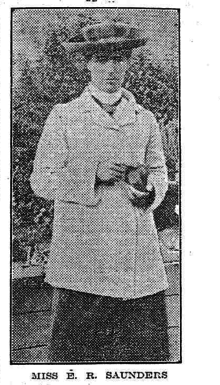Edith Rebecca Saunders
| Edith Rebecca Saunders | |
|---|---|
 | |
| Born |
14 October 1865 Brighton, East Sussex, United Kingdom |
| Died |
6 June 1945 (aged 79) Cambridge, Cambridgeshire, United Kingdom |
| Residence | England |
| Citizenship | British |
| Fields | genetics, plant anatomy |
| Author abbrev. (botany) | E.R.Saunders |
Edith Rebecca Saunders (14 October 1865 – 6 June 1945) was a British geneticist and plant anatomist. She had an active role in the re-discovery of Mendel's laws of heredity, being the first collaborator of the geneticist William Bateson. She also developed extensive work on plant anatomy, particularly focusing on the gynoecia, the female reproductive organs of flowers.
Biography
Saunders was born in Brighton in 1865. She was educated first at Handsworth Ladies' College and in 1884 she entered the female-only Newnham College, Cambridge.[1] There, she attended both Part I (in 1887) and II (in 1888) of the Natural Sciences Tripos.
She continued her post-graduate research, and served as a demonstrator at the Balfour Biological Laboratory for Women (where students from Newnham and Girton colleges received preparation for the Natural Sciences Tripos). In 1889 she became the director of the Laboratory. She was later director of studies at Girton College (1904–1914) and Newnham College (1918–1925).[2]
She was appointed a fellow of the Royal Horticulture Society from which she received the Banksian Medal in 1906. In 1905 she was one of the first women elected a fellow of the Linnean Society of London.
In 1920 she was the president of the botanical section of the British Association for the Advancement of Science. She also served as president of the Genetical Society, between 1936 and 1938.[3]
During World War II she served as a volunteer helping the Allied forces. She died soon after returning to Britain, in 1945, after suffering injuries in a bicycle accident.
Research
Saunders' earlier research focused on genetics. Many of her genetic experiments led to her and William Bateson defining important terms like "allelomorphs" (nowadays referred to as alleles), heterozygote and homozygote.[4] Furthermore, together with Bateson and Reginald Punnett she co-discovered genetic linkage.[5]
She also did extensive work in plant anatomy, particularly concerning gynoecia, having published several articles on the subject (noteworthy is her series of articles on "Illustrations of Carpel Polymorphism" published in the journal New Phytologist between 1928 and 1931).
See also
References
- ↑ Edith Rebecca Saunders entry on Encyclopædia Britannica: http://www.britannica.com/EBchecked/topic/1758746/Edith-Rebecca-Saunders
- ↑ Richmond, ML (2007). "Opportunities for women in early genetics". Nature Reviews Genetics. 8: 897–902. doi:10.1038/nrg2200.
- ↑ List of presidents of the Genetics Society: http://www.genetics.org.uk/About/PastPresidentsoftheSociety.aspx
- ↑ Bateson, W. and Saunders, E. R. (1902) "The facts of heredity in the light of Mendel’s discovery." Reports to the Evolution Committee of the Royal Society, I. pp 125-160
- ↑ Discovery and Types of Genetic Linkage, from Scitable
- ↑ IPNI. E.R.Saunders.